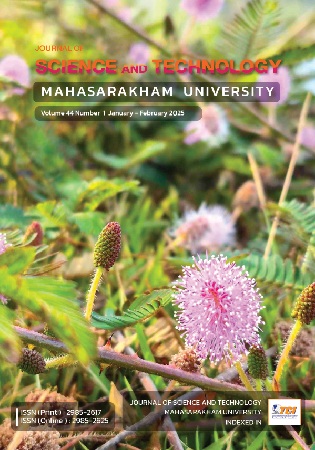Geospatial analysis to estimate the solar energy in household scale by geographic information systems
Main Article Content
Abstract
Solar energy is a clean, unlimited energy source that can be utilized without causing pollution or environmental harm. This study aimed to: 1) apply imagery from Unmanned Aerial Vehicles (UAVs) to create a Digital Surface Model (DSM) for generating a map of solar radiation potential areas at the household scale, and to analyze solar radiation using Geographic Information Systems (GIS); and 2) analyze the suitability of solar cell installation. The solar radiation potential areas were categorized into four levels: high, medium, low, and very low, with the very low level deemed unsuitable for installation. The study found that high-potential areas for solar cell installation are those that receive sunlight throughout the day, with an average radiation intensity greater than 5.28 kWh/m²/day, including open spaces and roofs.
Article Details
References
กรมพัฒนาพลังงานทดแทนและอนุรักษ์พลังงาน. (2563). แผนพัฒนาพลังงานทดแทนและพลังงานทางเลือก พ.ศ. 2561 -2580 (AEDP2018). [ออนไลน์]. แหล่งที่มา : https://www.dede.go.th/download/ Plan_62/20201021_TIEB_AEDP2018.pd.(19 มีนาคม 2565).
กรมพัฒนาพลังงานทดแทนและอนุรักษ์พลังงานกระทรวงพลังงาน. (2559). คู่มือฝึกอบรมภาคปฏิบัติด้านพลังงานทดแทน พลังงานแสงอาทิตย์. [ออนไลน์]. แหล่งที่มา : https:// BibA11106คู่มือแสงอาทิตย์59.pdf (dede.go.th). (23 ธันวาคม 2565).
คณะอนุกรรมการมาตรฐานการสำรวจด้วยอากาศยานไร้คนเพื่องานวิศวกรรม วิศวกรรมสถานแห่งประเทศไทยในพระบรมราชูปถัมภ์. (2565). มาตรฐานการสำรวจ
ด้วยอากาศยานไร้คนเพื่องานวิศวกรรม. พิมพ์ครั้งที่ 1. กรุงเทพฯ: วิศวกรรมสถานแห่งประเทศไทย ในพระบรมราชูปถัมภ์.
จารุวรรณ พิพัฒน์พุทธพันธ์. (2564). การพัฒนาพลังงานแสงอาทิตย์ควบคู่กับการทำเกษตรกรรมในโรงเรือน (Greenhouse) จากแนวคิดนโยบายของสาธารณะประชาชนจีน. [ออนไลน์]. แหล่งที่มา: https://webkc.dede.go.th/testmax/node/3151. (21 กันยายน 2566).
วิลาวัณย์ ประสมทรัพย์, ติณณ์ ถิรกุลโตมร, ธนกร ทอดสูงเนิน, ศิลาภรณ์ จันทะลุน และ ภาณุวิชญ์ เอ็นดู. (2560). การประมาณค่าปริมาณพลังงานแสงอาทิตย์ด้วยข้อมูลแบบจำลองภูมิประเทศเชิงตัวเลข จากอากาศยานไร้คนขับ. การประชุมวิชาการวิศวกรรมโยธาแห่งชาติครั้งที่ 25, วิศวกรรมสถานแห่งประเทศไทยในพระบรม
ราชูปถัมภ์ ร่วมกับ ภาควิชาวิศวกรรมโยธา มหาวิทยาลัยบูรพา สาขาวิศวกรรมโยธา มหาวิทยาลัยราชภัฏรไพพรรณี ภาควิชาวิศวกรรมโยธา มหาวิทยาลัยเกษตรศาสตร์วิทยาเขตศรีราชา, หน้า SGI22-1 - SGI22-6.
สามารถ วงษ์ฤทธิ์ และปฐมาภรณ์ ศรีผดุงธรรม. (2555). การวิเคราะห์ความเหมาะสมของพื้นที่สำหรับติดตั้งเซลล์แสงอาทิตย์ในประเทศไทยโดยใช้ฐานข้อมูลสารสนเทศภูมิศาสตร์ร่วมกับแผนที่ความเข้มรังสีดวงอาทิตย์. การประชุมทางวิชาการของมหาวิทยาลัยเกษตรศาสตร์ ครั้งที่ 50: สาขาสถาปัตยกรรมศาสตร์และวิศวกรรมศาสตร์. กรุงเทพฯ. หน้า 158-165.
Choi, Y., Suh, J. & Kim, S. M. (2019). GIS-Based Solar Radiation Mapping, Site Evaluation, and Potential Assessment: A Review. Applied Sciences, 9(1960):1-29. DOI: 10.3390/app9091960.
Cioban, A., Criveanu, H., Matei, F., Pop. I., & Rotaru, A. (2013). Aspects of Solar Radiation Analysis using ArcGIS, Bulletin UASVM Horticulture. 70(2)/2013, 437-440.https://www.researchgate.net/publication/311740728.
Dubayah, R. & P.M. Rich, A. (1995). Topographic solar radiation models for GIS. Journal of Geographic Information Systems 9. Volume 9 (1995), 405-413. https://doi.org/10.1080/02693799508902046.
ESRI. How Solar Radiation Is Calculated—ArcGIS Pro. Documentation. Available online: https://pro.arcgis.com/en/pro-app/latest/tool-reference/spatial-analyst/how-solar-radiation-is-calculated.htm (accessed on21 February 2021).
Hofierka, J.; Šúri, M. (2002). The solar radiation model for Open source GIS, Implementation andcapplications. In Proceedings of the Open-source GIS—GRASS users conference 2002, Trento, Italy, 11-13 September 2002; pp. 51-70.
Mihăilescu, A., & Cornelia-Badea, A. (2019). Analysing Solar Radiation in Suceava. E-Journal of Geodesy, Cartography and Cadastre, No,10 (2019), 49-54. https://jgcc.geoprevi.ro/index.php/issues/jgcc-no-10.
Kausika, B. B. & ; van Sark, W.G.J.H.M.. (2021). Calibration and Validation of ArcGIS Solar Radiation Tool for Photovoltaic Potential Determination in the Netherlands. Energies 2021, 14(7), 1865. https://doi.org/10.3390/en14071865.
Malgorzata, P. S. (2019). A GIS Open Source Software application for mapping solar energy resources in urban areas, E3S Web of Conferences 116, 00060(2019).https://doi.org/10.1051/e3sconf/201911600060.
Ramachandra, T.V. (2007). Solar energy potential assessment using GIS. Energy Education Science and Technology 2007 Volume(issue) 18(2): 101-114.
Rich, P.M., R. Dubayah, W.A. Hetrick & S.C. Saving, S.C. (1994). Using Viewshed models to calculate intercepted solar radiation. applications in ecology, American Society for Photogrammetry and Remote Sensing Technical Papers, 524-529.

